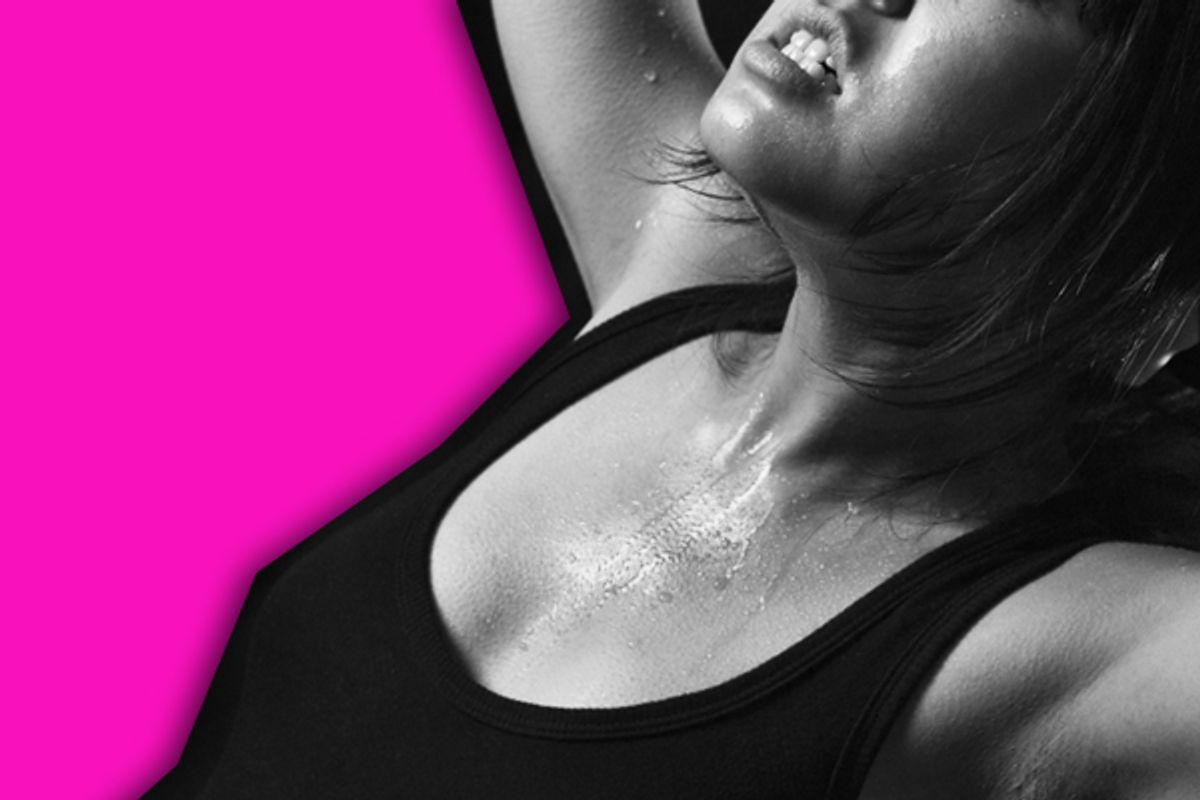“At the end of yoga,” my friend whispers, inching closer, “something sort of … strange happens.” A quick glance around confirms that the good patrons of Starbucks are less interested in her confession than they are in the nearby screaming banshee baby.
“I usually sit with my feet together and my knees splayed,” she continues tentatively, “for one final stretch before I take shavasana.” I nod her on. So far, I follow. “Leaning over to bring my head down to my feet, as my breath regulates I feel a sort of … tingling and pulsating down (ahem) there. And … the feeling isn’t entirely unwelcome.” She exhales, as if a great weight has lifted. “But I mean, that’s pretty weird, right?”
Turns out it’s actually not. Exercise-induced female sexual pleasure has been the subject of casual discussion and un-researched speculation for years. Even sexologist Alfred Kinsey mentions the phenomenon in his "Sexual Behaviors in the Human Female" (1953). But until now, the experience was mostly anecdotal. Now, a study by Indiana University researchers offers scientific evidence that confirms confessions once incredulously traded in gym class locker rooms.
According to Dr. Debby Herbenick, co-director of the Center for Sexual Health Promotion at IU and sexual health educator at the Kinsey Institute, the oft-deemed “coregasm” (because of its association with crunches) can actually be linked to various exercises, including abdominal workouts, biking, weight-lifting and climbing.
With co-author J. Dennis Fortenberry, M.D. and professor at the IU School of Medicine, Herbenick surveyed 370 women, ages 18 to 63, all of whom had experienced some sort of exercise-induced sexual experience prior to the study. Most of the women were in a relationship or married, and about 69 percent identified themselves as heterosexual. One hundred twenty-four of them had experienced exercise-induced orgasms (EIO) and 246 had experienced exercise-induced sexual pleasure (EISP). Forty percent of the women reported that they experienced sexual pleasure from exercise 10 times or more.
Published in a special issue of the peer-reviewed journal Sexual and Relationship Therapy, the findings may also be included in Herbenick’s new book, "Sex Made Easy," out in April. “It may be that exercise — which is already known to have significant benefits to health and well-being — has the potential to enhance women’s sexual lives as well,” Herbenick posited.
And while it might be tempting to conclude that ditching your vibrator for more reps at the gym will enhance your sex life, the findings of the recent study actually present a much more complex way of thinking about sexual pleasure. “These data are interesting because they suggest that orgasm is not necessarily a sexual event," said Herbenick. When orgasms are being had at the gym and on the track, our notion of female pleasure expands beyond the bedroom. When they occur independent of conventionally defined arousal, sensations characterized as “sexual” work to complicate our understanding of women’s bodies and experiences.
The data contributes to a deeper physiological understanding of the female orgasm, a phenomenon historically (when at all) described with mystical language and abounding question marks. The more research done on female orgasms, the more pleasure there is to be had.
Some researchers like Rutgers' Dr. Barry Komisaruk, co-author of 2006's "The Science of Orgasm," are trying to learn how to augment pleasure, as it is intimately tied to lessening pain. The experience behind each woman’s orgasm may be varied, but there are obviously overlaps in bodily processes. And the fact that it took only five weeks to recruit the 370 women for the study suggests that EIO is not so rare as one might think.
If you really want to know what exercises are more likely to bring you there, here’s a breakdown of the findings: 51.4 percent of the women reported experiencing an orgasm while doing abdominal exercises within the last 90 days, 26.5 percent while weight lifting, 20 percent during yoga, 15.8 percent bicycling, 13.2 percent running, and 9.6 percent walking or hiking.
But what about just sitting? The oft-repeated mantra "It’s all mental" can apply to orgasm as well, and it may be more than the muscle contraction involved in exercise that helps escort an orgasm into being. The blank state of mind or mental “transcendence” many report reaching while engaged in intense physical activity might contribute as well. Since for both women and men mental preoccupation and performance anxiety can hinder orgasm, feeling relaxed and in no rush is key. What better state of mind to come than one of abandoned transcendence, achieved by leisurely lunging?
Some women are even able to intentionally think themselves to orgasm. Dr. Komisaruk studies the function of nerve pathways for sexual stimulation in women. He’s researched the phenomenon and reports that the pleasure centers of the brain associated with orgasm light up in women who mentally climax in exactly the same way as when orgasm is reached by more traditional means. So how do they do it? Some use breathing exercises and fantasize, others engage in pelvic floor exercises like the well-known Kegel.
Interestingly, the orgasm activates the same part of the brain as pain: the anterior cingulate cortex and the insula. Komisaruk’s work explores the differences between pleasure and pain, and what makes vastly different experiential extremes translate into the same brain activity.
Techniques used by subjects while “thinking off” varied tremendously. Komisaruk describes, “Some imagined erotic scenarios. But others imagined very romantic scenes such as a lover whispering to them. Others pictured more abstract sensual experiences, such as walking along a beach or imagining waves of energy moving through their body.” Unsurprisingly, the path to pleasure can be as different as each individual.
So take your tingly shavasanas with pride and curiosity. I assure you, the woman in crow pose one mat over has no idea what’s going on.



Shares